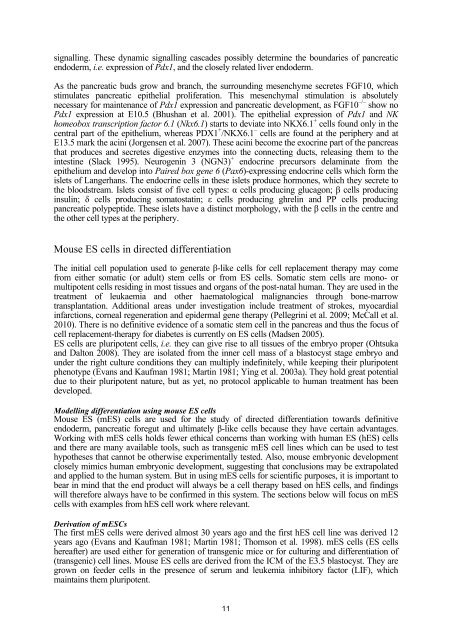FGF-signalling in the differentiation of mouse ES cells towards ...
FGF-signalling in the differentiation of mouse ES cells towards ...
FGF-signalling in the differentiation of mouse ES cells towards ...
You also want an ePaper? Increase the reach of your titles
YUMPU automatically turns print PDFs into web optimized ePapers that Google loves.
<strong>signall<strong>in</strong>g</strong>. These dynamic <strong>signall<strong>in</strong>g</strong> cascades possibly determ<strong>in</strong>e <strong>the</strong> boundaries <strong>of</strong> pancreaticendoderm, i.e. expression <strong>of</strong> Pdx1, and <strong>the</strong> closely related liver endoderm.As <strong>the</strong> pancreatic buds grow and branch, <strong>the</strong> surround<strong>in</strong>g mesenchyme secretes <strong>FGF</strong>10, whichstimulates pancreatic epi<strong>the</strong>lial proliferation. This mesenchymal stimulation is absolutelynecessary for ma<strong>in</strong>tenance <strong>of</strong> Pdx1 expression and pancreatic development, as <strong>FGF</strong>10 –/– show noPdx1 expression at E10.5 (Bhushan et al. 2001). The epi<strong>the</strong>lial expression <strong>of</strong> Pdx1 and NKhomeobox transcription factor 6.1 (Nkx6.1) starts to deviate <strong>in</strong>to NKX6.1 + <strong>cells</strong> found only <strong>in</strong> <strong>the</strong>central part <strong>of</strong> <strong>the</strong> epi<strong>the</strong>lium, whereas PDX1 + /NKX6.1 – <strong>cells</strong> are found at <strong>the</strong> periphery and atE13.5 mark <strong>the</strong> ac<strong>in</strong>i (Jorgensen et al. 2007). These ac<strong>in</strong>i become <strong>the</strong> exocr<strong>in</strong>e part <strong>of</strong> <strong>the</strong> pancreasthat produces and secretes digestive enzymes <strong>in</strong>to <strong>the</strong> connect<strong>in</strong>g ducts, releas<strong>in</strong>g <strong>the</strong>m to <strong>the</strong><strong>in</strong>test<strong>in</strong>e (Slack 1995). Neurogen<strong>in</strong> 3 (NGN3) + endocr<strong>in</strong>e precursors delam<strong>in</strong>ate from <strong>the</strong>epi<strong>the</strong>lium and develop <strong>in</strong>to Paired box gene 6 (Pax6)-express<strong>in</strong>g endocr<strong>in</strong>e <strong>cells</strong> which form <strong>the</strong>islets <strong>of</strong> Langerhans. The endocr<strong>in</strong>e <strong>cells</strong> <strong>in</strong> <strong>the</strong>se islets produce hormones, which <strong>the</strong>y secrete to<strong>the</strong> bloodstream. Islets consist <strong>of</strong> five cell types: α <strong>cells</strong> produc<strong>in</strong>g glucagon; β <strong>cells</strong> produc<strong>in</strong>g<strong>in</strong>sul<strong>in</strong>; δ <strong>cells</strong> produc<strong>in</strong>g somatostat<strong>in</strong>; ε <strong>cells</strong> produc<strong>in</strong>g ghrel<strong>in</strong> and PP <strong>cells</strong> produc<strong>in</strong>gpancreatic polypeptide. These islets have a dist<strong>in</strong>ct morphology, with <strong>the</strong> β <strong>cells</strong> <strong>in</strong> <strong>the</strong> centre and<strong>the</strong> o<strong>the</strong>r cell types at <strong>the</strong> periphery.Mouse <strong>ES</strong> <strong>cells</strong> <strong>in</strong> directed <strong>differentiation</strong>The <strong>in</strong>itial cell population used to generate β-like <strong>cells</strong> for cell replacement <strong>the</strong>rapy may comefrom ei<strong>the</strong>r somatic (or adult) stem <strong>cells</strong> or from <strong>ES</strong> <strong>cells</strong>. Somatic stem <strong>cells</strong> are mono- ormultipotent <strong>cells</strong> resid<strong>in</strong>g <strong>in</strong> most tissues and organs <strong>of</strong> <strong>the</strong> post-natal human. They are used <strong>in</strong> <strong>the</strong>treatment <strong>of</strong> leukaemia and o<strong>the</strong>r haematological malignancies through bone-marrowtransplantation. Additional areas under <strong>in</strong>vestigation <strong>in</strong>clude treatment <strong>of</strong> strokes, myocardial<strong>in</strong>farctions, corneal regeneration and epidermal gene <strong>the</strong>rapy (Pellegr<strong>in</strong>i et al. 2009; McCall et al.2010). There is no def<strong>in</strong>itive evidence <strong>of</strong> a somatic stem cell <strong>in</strong> <strong>the</strong> pancreas and thus <strong>the</strong> focus <strong>of</strong>cell replacement-<strong>the</strong>rapy for diabetes is currently on <strong>ES</strong> <strong>cells</strong> (Madsen 2005).<strong>ES</strong> <strong>cells</strong> are pluripotent <strong>cells</strong>, i.e. <strong>the</strong>y can give rise to all tissues <strong>of</strong> <strong>the</strong> embryo proper (Ohtsukaand Dalton 2008). They are isolated from <strong>the</strong> <strong>in</strong>ner cell mass <strong>of</strong> a blastocyst stage embryo andunder <strong>the</strong> right culture conditions <strong>the</strong>y can multiply <strong>in</strong>def<strong>in</strong>itely, while keep<strong>in</strong>g <strong>the</strong>ir pluripotentphenotype (Evans and Kaufman 1981; Mart<strong>in</strong> 1981; Y<strong>in</strong>g et al. 2003a). They hold great potentialdue to <strong>the</strong>ir pluripotent nature, but as yet, no protocol applicable to human treatment has beendeveloped.Modell<strong>in</strong>g <strong>differentiation</strong> us<strong>in</strong>g <strong>mouse</strong> <strong>ES</strong> <strong>cells</strong>Mouse <strong>ES</strong> (m<strong>ES</strong>) <strong>cells</strong> are used for <strong>the</strong> study <strong>of</strong> directed <strong>differentiation</strong> <strong>towards</strong> def<strong>in</strong>itiveendoderm, pancreatic foregut and ultimately β-like <strong>cells</strong> because <strong>the</strong>y have certa<strong>in</strong> advantages.Work<strong>in</strong>g with m<strong>ES</strong> <strong>cells</strong> holds fewer ethical concerns than work<strong>in</strong>g with human <strong>ES</strong> (h<strong>ES</strong>) <strong>cells</strong>and <strong>the</strong>re are many available tools, such as transgenic m<strong>ES</strong> cell l<strong>in</strong>es which can be used to testhypo<strong>the</strong>ses that cannot be o<strong>the</strong>rwise experimentally tested. Also, <strong>mouse</strong> embryonic developmentclosely mimics human embryonic development, suggest<strong>in</strong>g that conclusions may be extrapolatedand applied to <strong>the</strong> human system. But <strong>in</strong> us<strong>in</strong>g m<strong>ES</strong> <strong>cells</strong> for scientific purposes, it is important tobear <strong>in</strong> m<strong>in</strong>d that <strong>the</strong> end product will always be a cell <strong>the</strong>rapy based on h<strong>ES</strong> <strong>cells</strong>, and f<strong>in</strong>d<strong>in</strong>gswill <strong>the</strong>refore always have to be confirmed <strong>in</strong> this system. The sections below will focus on m<strong>ES</strong><strong>cells</strong> with examples from h<strong>ES</strong> cell work where relevant.Derivation <strong>of</strong> m<strong>ES</strong>CsThe first m<strong>ES</strong> <strong>cells</strong> were derived almost 30 years ago and <strong>the</strong> first h<strong>ES</strong> cell l<strong>in</strong>e was derived 12years ago (Evans and Kaufman 1981; Mart<strong>in</strong> 1981; Thomson et al. 1998). m<strong>ES</strong> <strong>cells</strong> (<strong>ES</strong> <strong>cells</strong>hereafter) are used ei<strong>the</strong>r for generation <strong>of</strong> transgenic mice or for cultur<strong>in</strong>g and <strong>differentiation</strong> <strong>of</strong>(transgenic) cell l<strong>in</strong>es. Mouse <strong>ES</strong> <strong>cells</strong> are derived from <strong>the</strong> ICM <strong>of</strong> <strong>the</strong> E3.5 blastocyst. They aregrown on feeder <strong>cells</strong> <strong>in</strong> <strong>the</strong> presence <strong>of</strong> serum and leukemia <strong>in</strong>hibitory factor (LIF), whichma<strong>in</strong>ta<strong>in</strong>s <strong>the</strong>m pluripotent.11
















